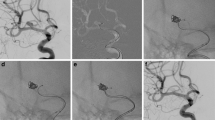Abstract
Introduction
Within the neurosurgical literature on intracranial aneurysms, balloon-assisted coiling (BAC) remains controversial when compared to conventional coiling (CC). The aim of this study was to compare our results with BAC and CC over a 4-year period.
Methods
Daily interventional neuroradiology has been available since March 2004 in our institution. Between March 2004 and February 2008, 275 patients with 357 aneurysms were treated by an endovascular approach, including 174 patients/204 aneurysms treated by CC (group I) and 80 patients/92 aneurysms treated by BAC (group II). The remaining patients were treated with other endovascular techniques. Indications of BAC were as follow: aneurysms with an unfavourable neck/sac ratio and/or a branch arising from the neck (90.2%), unstable coiling catheter (6.5%), and anticipated aneurysm rupture (3.3%). The clinical charts, procedural data, and angiographic results of groups I and II were compared.
Results
BAC was used in 25.8% (92/357) of all embolized aneurysms and it was successful in 83/92 aneurysms (90%). There was no significant difference in the procedure-related morbidity and mortality rates between group I (2.3% and 1.15%, respectively) and group II (2.5% and 1.25%, respectively). Although retreatment was more frequent in group II (13%) than in group I (11%), the difference was not statistically significant (P = 0.8125).
Conclusion
When BAC is used frequently, it is a safe and effective technique that is associated with complication rates comparable to those of CC. Although BAC is not associated with more stable anatomical results, it should be considered as an alternative therapeutic option for the treatment of broad-based intracranial aneurysms.



Similar content being viewed by others
References
Moret J, Pierot L, Boulin A et al (1994) “Remodelling” of the arterial wall of the parent vessel in the endovascular treatment of intracranial aneurysms. Neuroradiology 36 [Suppl 1]:S83
Moret J, Cognard C, Weill A, Castaings L, Rey A (1997) The reconstruction technique in the treatment of wide-neck intracranial aneurysms: long-term angiographic and clinical results. J Neuroradiol 24:30–44
Lefkowitz MA, Gobin YP, Akiba Y et al (1999) Balloon-assisted Guglielmi detachable coiling of wide-necked aneurysms: Part II – clinical results. Neurosurgery 45:531–536
Aletich VA, Debrun GM, Misra M, Charbel F, Ausman JI (2000) The remodeling technique of balloon-assisted Guglielmi detachable coil placement in wide-necked aneurysms: experience at the university of Illinois at Chicago. J Neurosurg 93:388–396
Nelson PK, Levy DI (2001) Balloon-assisted coil embolization of wide-necked aneurysms of the internal carotid artery: medium-term angiographic and clinical follow-up in 22 patients. AJNR Am J Neuroradiol 22:19–26
Cottier JP, Pasco A, Gallas S et al (2001) Utility of balloon-assisted Guglielmi detachable coiling in the treatment of 49 cerebral aneurysms: a retrospective, multicenter study. AJNR Am J Neuroradiol 22:345–351
Lubicz B, Leclerc X, Gauvrit JY, Lejeune JP, Pruvo JP (2004) Hyperform remodelling-balloon for endovascular treatment of wide-neck intracranial aneurysms. AJNR Am J Neuroradiol 25:1381–1383
White JB, Layton KF, Kallmes DF, Cloft HJ (2006) Balloon-assisted coiling through a 5-French system. Neuroradiology 49:157–159
Ross IB, Dhillon GS (2006) Balloon assistance as a routine adjunct to the endovascular treatment of cerebral aneurysms. Surg Neurol 66:593–601
Layton KF, Cloft HJ, Gray LA, Lewis DA, Kallmes DF (2007) Balloon-assisted coiling of intracranial aneurysms: evaluation of local thrombus formation and symptomatic thromboembolic complications. AJNR Am J Neuroradiol 28:1172–1175
Lubicz B, Lefranc F, Levivier M et al (2006) Endovascular treatment of intracranial aneurysms with a branch arising from the sac. AJNR Am J Neuroradiol 27:142–147
Soeda A, Sakai N, Sakai H et al (2003) Thromboembolic events associated with Guglielmi detachable coil embolization of asymptomatic cerebral aneurysms: evaluation of 66 consecutive cases with use of diffusion-weighted MR imaging. AJNR Am J Neuroradiol 24:127–132
Sluzewski M, Van Rooij WJ, Beute GN, Nijssen PC (2006) Balloon-assisted coil embolization of intracranial aneurysms: incidence, complications, and angiography results. J Neurosurg 105:396–399
Gulielmi G, Vinuela F, Dion J, Duckwiler G (1991) Electrothrombosis of saccular aneurysms via endovascular approach. Part 2: preliminary clinical experience. J Neurosurg 75:8–14
Guglielmi G, Vinuela F, Duckwiler G et al (1992) Endovascular treatment of posterior circulation aneurysms by electrothrombosis using electrically detachable coils. J Neurosurg 77:515–524
Jennett B, Bond M (1975) Assessment of outcome after severe brain damage: a practical scale. Lancet 1:480–484
Hunt W, Hess R (1968) Surgical risk as related to time of intervention in the repair of intracranial aneurysms. J Neurosurg 28:14–20
Henkes H, Fischer S, Weber W et al (2004) Endovascular coil occlusion of 1811 intracranial aneurysms: early angiographic and clinical results. Neurosurgery 54:268–280
Murayama Y, Nien LY, Duckwiler G et al (2003) Guglielmi detachable coil embolization of cerebral aneurysms: 11 years’ experience. J Neurosurg 98:959–966
Mejdoubi M, Gigaud M, Tremoulet M, Albucher JF, Cognard C (2006) Initial primary endovascular treatment in the management of ruptured intracranial aneurysms: a prospective consecutive series. Neuroradiology 48:899–905
Malek AM, Halbach VV, Phatouros CC et al (2000) Balloon-assist technique for endovascular coil embolization of geometrically difficult intracranial aneurysms. Neurosurgery 46:1397–1406
Singh V, Gress DR, Higashida RT, Dowd CF, van Halbach V, Johnston SC (2002) The learning curve for coil embolization of unruptured intracranial aneurysms. AJNR Am J Neuroradiol 23:768–771
Raymond J, Guilbert F, Weill A et al (2003) Long-term angiographic recurrences after selective endovascular treatment of aneurysms with detachable coils. Stroke 34:1398–1403
Henkes H, Fischer S, Liebig T et al (2006) Repeated endovascular coil occlusion in 350 of 2759 intracranial aneurysms: safety and effectiveness aspects. Neurosurgery. 58:224–232
Slob MJ, Sluzewski M, van Rooij WJ, Roks G, Rinkel GJ (2004) Additional coiling of previously coiled cerebral aneurysms: clinical and angiographic results. AJNR Am J Neuroradiol 25:1373–1376
Conflict of interest statement
We declare that we have no conflict of interest.
Author information
Authors and Affiliations
Corresponding author
Rights and permissions
About this article
Cite this article
Lubicz, B., Lefranc, F., Bruneau, M. et al. Balloon-assisted coiling of intracranial aneurysms is not associated with a higher complication rate. Neuroradiology 50, 769–776 (2008). https://doi.org/10.1007/s00234-008-0397-3
Received:
Accepted:
Published:
Issue Date:
DOI: https://doi.org/10.1007/s00234-008-0397-3




